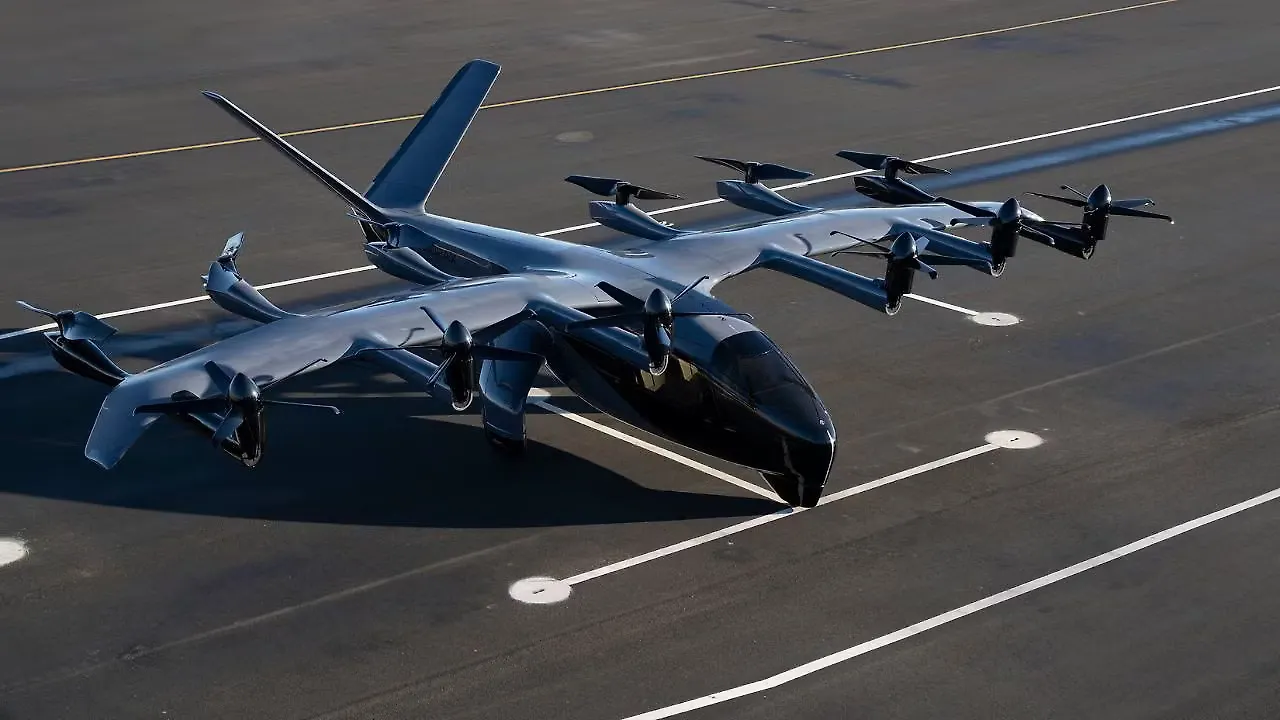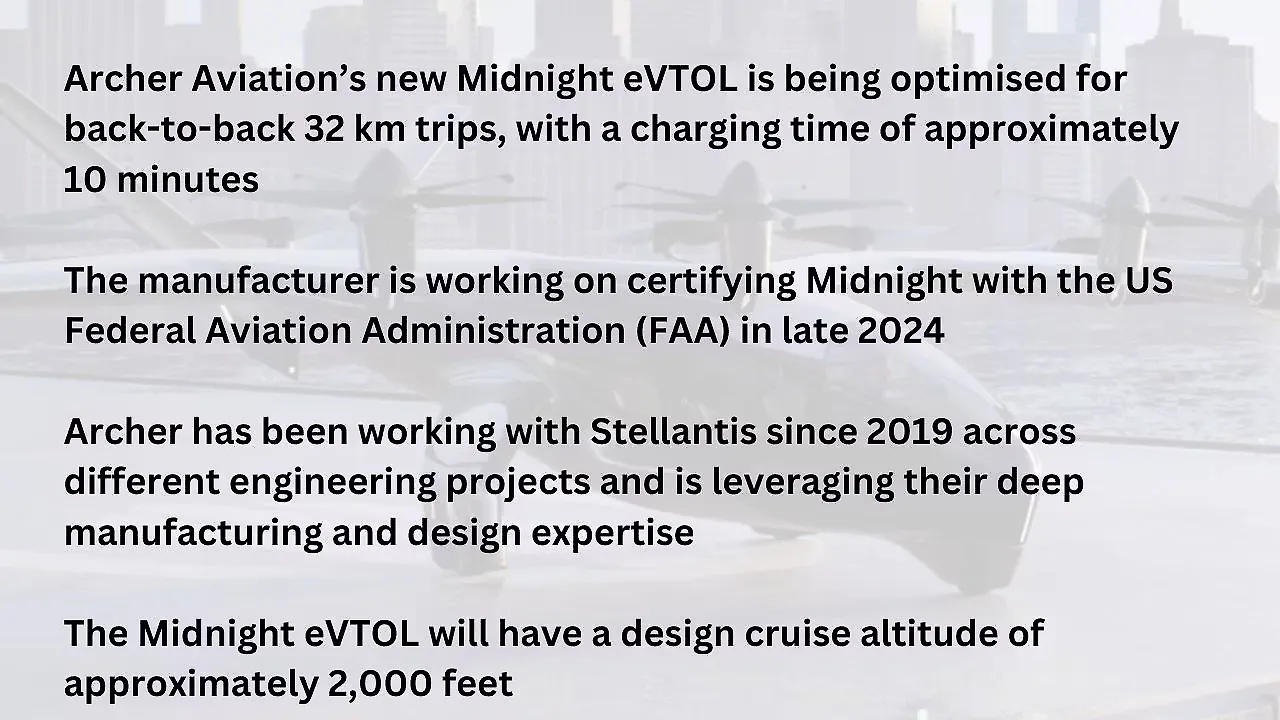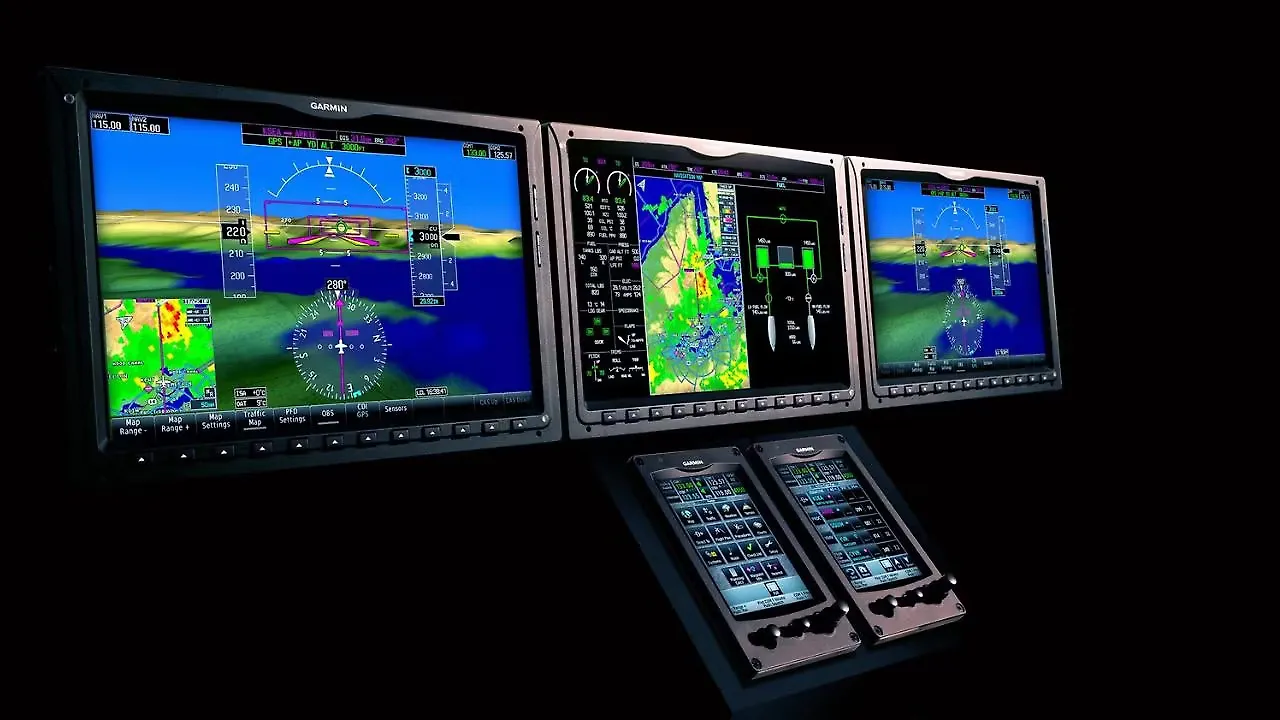
Archer Aviation Inc. (Archer), an early leader in electric vertical take-off and landing (eVTOL) aircraft based in Santa Clara, USA, recently unveiled the production version of its eVTOL called ‘Midnight’.
An evolution of Archer’s ‘Maker’ eVTOL aircraft demonstrator, the Midnight has the same configuration but is slightly larger to support its 500kg payload capability and carry a pilot with four passengers. Archer had originally planned to unveil the production of eVTOL in 2023 but pulled the launch forward due to its confidence in the programme.
The new Midnight eVTOL is being optimised for back-to-back 32 km trips, with a charging time of approximately 10 minutes. Archer is working to certify Midnight with the US Federal Aviation Administration (FAA) in late 2024 and will use it as part of its Urban Air Mobility (UAM) network that it plans to launch in 2025.
Archer’s first point-to-point route will be operated by the US carrier United between Downtown Manhattan Heliport, one of the world's most advanced and well-known heliports, and New York Liberty International Airport, one of United's largest hubs. Archer has already received a $10 million pre-delivery payment from United, representing a deposit on the first 100 aircraft it will receive as part of a 200 aircraft order.
Adam Goldstein, Founder and CEO, Archer, said, “From day one Archer’s strategy has always been about finding the most efficient path to commercialising eVTOL aircraft.We believe our strategy and team's ability to execute on it has allowed us to establish our leadership position in the market, and is why we are confident we will be the first company to certify an eVTOL aircraft in the US with the FAA.”
Mark Mesler, CFO, Archer, said the company was continuing to push towards commercialisation, with the vast majority of resources focused on completing the development and certification of Midnight, building out its manufacturing and supply chain capabilities and hardening the company’s go-to-market plans.
The company also has a highly significant strategic partnership with Stellantis, one of the largest global auto OEMs, with brands including Jeep, Ram and Maserati. Stellantis has played a critical role in Archer’s manufacturing journey as it has a core competency in high-volume manufacturing, building millions of cars annually.
“We have been working with Stellantis since 2019 across different engineering projects, and we continue to leverage their deep manufacturing and design expertise. Importantly, Stellantis is fully committed to EV and are investing tens of billions to advance electrification across its portfolio. We look forward to maturing our relationship as we transition into production,” Goldstein said.
Racing Ahead
Archer completed Midnight’s Preliminary Design Review (PDR) covering all aspects of the aircraft’s specifications and manufacturing requirements in August. Completing PDR allowed it to determine that the design is feasible for Type Certification and commercialisation. It has been said that the Maker eVTOL demonstrator’s flight testing programme is on schedule to complete a full transition flight in the coming weeks. On November 2, the Maker eVTOL flew its first wing-borne flight above the stall speed generating lift from the wing. Archer has joined a select club of companies which have done such a flight with a vectored thrust eVTOL configuration. The stall speed is the speed at which an aircraft is unable to maintain flight.

The eVTOL manufacturer validated its proprietary twelve-tilt-six configuration and key enabling technologies on the Maker eVTOL demonstrator. The Maker eVTOL made its first hover flight a year ago, and the flight test programme has generated invaluable data since then, which Archer has leveraged in developing and certifying the new Midnight eVTOL.
The company has been focusing on in-house development only for key enabling technologies which it cannot source from the existing aerospace supply base. As a result, it has focussed its internal development efforts on key technical enablers like batteries, motors, and flight control software. This approach has allowed it to rely on partners to supply components already used on certified aircraft today. This has allowed the company to dramatically reduce its certification risks, development timelines, and costs.
The company had announced three goals for 2022: making a transition flight for the Maker, FAA acceptance of compliance and selecting a manufacturing site. The first Maker transition flight will make a major milestone for the programme. Transition is the phase of flight between hover and cruise, where the aircraft transitions from the lift generated by the propellers to the lift generated by the wing, called wing-borne flight. During a full transition flight, the tilt propellers will be locked in the cruise position. Archer has submitted its means of compliance to the FAA, which will be approved after review by the FAA.
Archer’s eVTOL manufacturing facility will be located on a 96-acre site in Covington, Georgia, adjacent to the Covington Municipal Airport. The company plans to invest $118 million over the next ten years and will receive an incentive package totalling 33% of its capital investment commitment, which includes land conveyance, tax incentives and a Georgia REBA grant. Archer will construct a 350,000-sqft facility capable of producing up to 650 aircraft annually. The facility is expected to be completed in the first half of 2024, with initial production expected to begin in the year's second half. The facility could also be expanded by an additional 550,000 sqft, which could support the production of up to 2,300 eVTOLs per year.
Viable Model
During Archer’s Q322 Earnings Call in early November, Mesler provided an insight into how payload would impact UAM unit-level economics of its UAM business model. He gave the example of a sample UAM route, which would cover a distance of 24 km and support 25 trips per aircraft per day. “From a top-line standpoint, assuming indicative pricing similar to current ridesharing services, revenue would be $90 per seat per trip. That is roughly $6 per seat mile,” he said. The revenue would scale as the aircraft capacity is filled, growing from $90 for one seat to $360 for four seats.
At 25 trips per aircraft per day, operating 365 days per year, it would generate approximately $3.2 million of revenue per year, Mesler outlined. He said this was 50% more revenue potential or approximately $1.6 million more potential revenue per aircraft, than that which could be achieved with a smaller payload two-seat aircraft.
From a cost standpoint, Mesler said the direct operating costs between two-passenger or four-passenger capacity are directionally about the same because their weight and ancillary fixed costs are very similar. “Given that, simply put, we believe payload unlocks the potential for greater profitability,” he said. As a result, he said, that given the density of these routes, Archer’s modelling confirms that high load factors were expected on this particular route and the aircraft would likely operate at or near capacity.
Urban Design
The Midnight eVTOL will have a design cruise altitude of approximately 2,000 feet. With eVTOLs being designed for operations in urban areas, Archer says that Midnight's noise level at the ground is expected to measure around 45 A-weighted decibels (dBA). This will make it nearly 1,000 times quieter than a helicopter as its aircraft has 12 small propellers compared to one large rotor on a helicopter. As a result, they spin at significantly lower tip speeds, resulting in much lower noise levels.
Archer has invested heavily in ensuring that the Midnight eVTOL features high redundancy and simplified propulsion systems to make it a significantly safer aircraft than a helicopter.
The Midnight VTOL is also designed to not have any critical points of failure; the aircraft can still safely complete its flight if any component fails. An eVTOL’s electric motors also have significantly fewer moving parts than gas turbine or piston engines, allowing them to operate with less maintenance and lower overall risk.

The company has already selected more than 64% of the suppliers for Midnight’s bill of materials. Key suppliers include Garmin, which will supply its G3000 integrated flight deck, offering the configuration needed to bring the Midnight eVTOL aircraft to market. The large format displays and intuitive controls will provide pilots with the situational awareness needed to operate Midnight.
Taiwan-based E-One Moli Energy Corp. (Molicel), an industry-leading supplier of lithium-ion battery cells, will supply the aircraft. Molicel announced last year that it plans to establish its first Gigafactory in Taiwan, which is scheduled to ramp up production in 2023. The facility will have the capacity to produce 1.8 gigawatt-hours (GWh) of battery capacity annually.
As an all-electric VTOL aircraft, Midnight will have zero operating emissions and Archer’s design and engineering teams have worked hard to integrate sustainable materials into this aircraft, such as seats which are made out of “flax” fibre, a natural plant which requires very little irrigation and is highly absorbent of CO2. The seat fabric is made from recycled contents like plastic bottles.
Also Read
Archer’s eVTOL Demonstrator Aircraft Completes First Hover Flight
Garuda Aerospace Earns RPTO Certification From DGCA